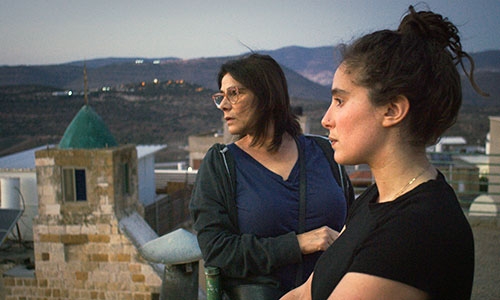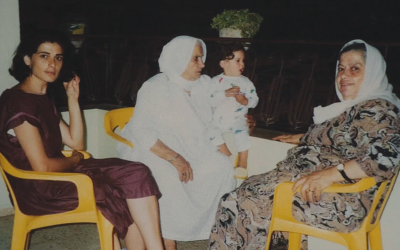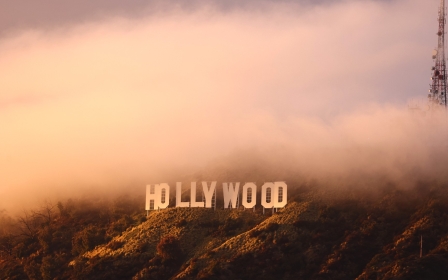Bye Bye Tiberias: Fighting Palestinian erasure through the act of remembering

Bye Bye Tiberias opens with grainy VHS footage of a woman and her child swimming in the waters of Lake Tiberias on the western shore of the Sea of Galilee.
The Franco-Palestinian-Algerian director Lina Soualem narrates: “As a child, my mother took me swimming in this lake as if to bathe me in her story.”
This cinematic memoir attempts to tell that story by gathering and piecing together the memories of her family, dispersed by the Israeli occupation.
The story is bookended by the lake, where they lived before the Nakba in 1948, when 700,000 Palestinians were displaced by Israel.
In the present day, Hiam Abbass (widely known in the West for her role as Marcia Roy in Succession) revisits the lake with her mother, Nemet. They find its shores ringed in barriers and lined with shops emblazoned with neon shop signs in Hebrew. They try to reflect in silence but are interrupted by blaring pop music and the approach of Israeli soldiers.
New MEE newsletter: Jerusalem Dispatch
Sign up to get the latest insights and analysis on Israel-Palestine, alongside Turkey Unpacked and other MEE newsletters
The film follows Abbass, who left the village of Deir Hanna at the age of 23 to pursue an acting career in France, as she revisits her home to care for the ailing Nemet.
Soualem charts the history of Palestinian displacement through the stories of four generations of women in her family, of which she is the fourth.
These include her great-grandmother, Um Ali, who fled Tiberias in 1948 with her husband and eight children; her great-aunt, Hosnieh, who found refuge in Syria following exile; and her mother, Hiam, who left Palestine for Europe in her 20s.
Thousand-yard stare
Bye Bye Tiberias attempts to weave their stories together through a patchwork of 90s home videos, archival footage, family photographs, poetry and present-day interviews with Abbass and her sisters.
In a recurring motif throughout the film, Soualem and her mother arrange photographs on the wall of her grandmother’s flat, forming a patchy map of their family history.
Camcorder footage from Soualem’s annual childhood visits to Deir Hanna often captures the four women together but continually switches focus from one woman to another - from the young Soualem engrossed in play to Um Ali meditatively plaiting her white hair.
In the compilation of home movies, photographs and interviews with her daughter, Abbass seems removed. She frequently averts her gaze from the camera, her eyes flickering into the middle distance.
In a teenage photograph, she wears the same thousand-yard stare. Video footage of her second wedding shows Abbass staring off into space amid the beaming guests.
Abbass’ yearning to escape her home - expressed in the poetry she wrote by night as a teenager, which she recites to the camera - is accompanied by a powerful desire to return to it
Aware of her mother’s discomfort, Soualem introduced alternative ways of depicting the past by getting Abbass to re-enact conversations with her father, her sister and a former colleague at the Palestinian National Theatre.
As Soualem urges her mother to turn towards the camera, Abbass snaps: “What are you after, Lina?”
Abbass’ yearning to escape her home - expressed in the poetry she wrote by night as a teenager, which she recites to the camera - is accompanied by a powerful desire to return to it.
The paradox is movingly encapsulated in her description of a reunion with her aunt, Hosnieh. Abbass’ French passport allowed her to cross the border that split the family in 1948, barring Hosnieh from returning. Abbass describes how they were drawn together “like magnets”.
'Don't abandon me'
In one scene, she stands on the balcony, turns on the spot and points towards the sea, Lebanon, Syria and Jordan.
“And here we are in the middle,” she concludes.
Her sense of “in-betweenness” mirrors the condition of Palestine itself.
In a WhatsApp call with Abbass, her mother, Nemet, pleads: “Don’t abandon me.”

It is the last time we see her before her death.
While the Israeli occupation does not feature prominently in the film’s footage, it forms a constant background noise. The roar of a jet flying overhead or khaki-clad soldiers marching past Abbass on the shores of Lake Tiberias interrupts their efforts to preserve the material trace of their memories.
Its violence is felt in the fractured stories of four generations of women, which Soualem lovingly tries to piece back together.
Soualem notes that even her knowledge of Arabic is a “fragment” of her mother’s language.
The film is an attempt to counteract that violence and to counteract Palestinian erasure by preserving and transmitting memory.
“What if the remains of this place were to disappear?” Soualem speculates as the film closes.
As we witness the erasure of Gaza, where over 40,000 people have been killed by Israeli forces and more than half of its buildings razed to the ground, this question has become even more pertinent and the act of remembering a more urgent form of resistance.
The views expressed in this article belong to the author and do not necessarily reflect the editorial policy of Middle East Eye.
Middle East Eye delivers independent and unrivalled coverage and analysis of the Middle East, North Africa and beyond. To learn more about republishing this content and the associated fees, please fill out this form. More about MEE can be found here.





